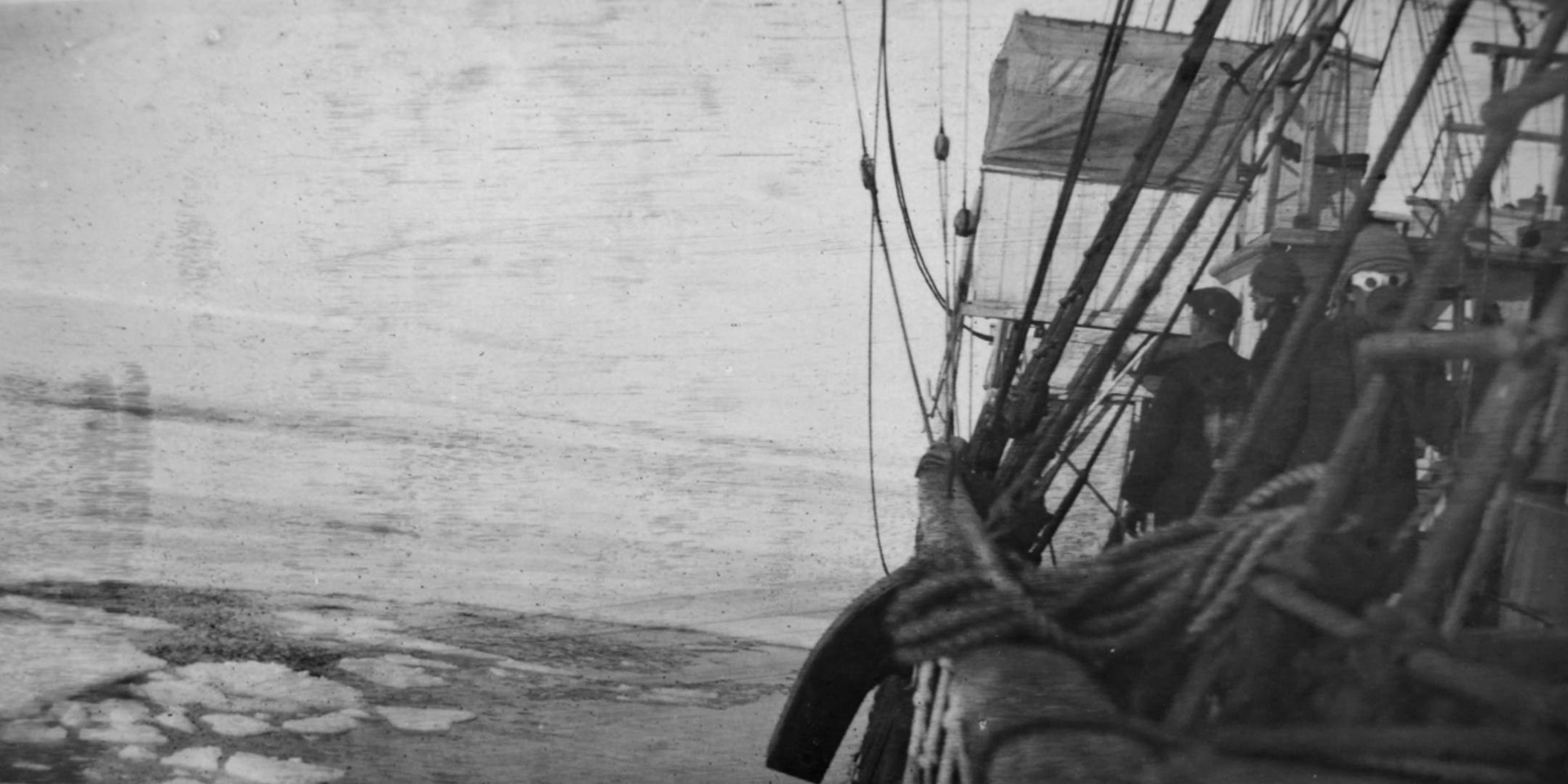
After Shackleton’s incredible trek to South Georgia and the rescue of the Endurance crew in August, he sailed for New Zealand to assist with the rescue of the marooned Ross Sea sledging party.
Aurora at the time of rescue at McMurdo Sound. Photographer: Frederick Middleton. Courtesy the Middleton family and Canterbury Museum, Middleton Collection
With war continuing, the relief effort took months. Protracted negotiations between Australia, New Zealand and Britain resulted in those governments funding the voyage under the command of veteran Antarctic sailor John King Davis, with Shackleton as a supernumerary. Aurora was repaired and refitted for the relief voyage, and the ship entered McMurdo Sound, mooring near Cape Evans on 10 January 1917.
The men waiting in the hut there had hoped for a relief ship that summer. Still surprised to see their old ship Aurora apparently moored to the ice, six of the seven survivors trudged towards it to find Shackleton among the figures approaching them. Some of them had not met the famed explorer, harbouring some residual reservations. Shackleton’s charisma and care disarmed them as they recuperated on board in his company.
As to the conditiion of the men, the relief expedition’s medical officer, Frederick Middleton, noted:
They looked very fit physically but very unkempt and their clothes were about on their last legs … We talked straightaway about the war. They were surprised it was still on … and then they had their first smoke of tobacco for close on two years…McElrea and Harrowfield, Polar Castaways, p 247
John King Davis found that they stunk of blubber and seal.
Six of the seven survivors greet the rescue party, Ernest Joyce, Richard Richards, Harry Ernest Wild, Irvine Gaze, Alexander Stevens, John Cope. Andrew Keith Jack was finishing work in the hut. Photographer: Frederick Middleton. Courtesy the Middleton family and Canterbury Museum, Middleton Collection
Captain Davis quickly departed McMurdo Sound and a few weeks later arrived in New Zealand. Shackleton had escorted the men from both parties to safety along with the four surviving Ross Sea dogs.
The seven survivors of the Ross Sea Party with their mascot Oscar, from left, Andrew Keith Jack, Alexander Stevens, Richard Richards, Harry Ernest Wild, Irvine Gaze, Ernest Joyce, John Cope, Sir Ernest Shackleton and Captain John King Davis, January 1917. Frederick Middleton photographer, courtesy the Middleton family, State Library Victoria from the estate of Andrew Keith Jack 1967
Shackleton himself returned to the UK to a world badly bruised by war. His great survival story, which risked and lost lives of able-bodied men was by then considered reckless when thousands were dying to defend the Empire. Shackleton found himself out of favour.
Sir Ernest Shackleton with Andrew Keith Jack on Aurora upon return to Wellington, New Zealand, 1917. Frederick Middleton photographer, courtesy the Middleton family and Canterbury Museum, Middleton Collection
But Shackleton’s leadership during the Endurance crew’s terrible ordeal had engendered tremendous loyalty from a small group of his men. In 1921 they followed him to the ends of the earth once more when Shackleton, yearning for lost dreams, set out on the Quest to the high latitudes of the Southern Ocean to circumnavigate the continent ‘for the purposes of scientific research and discovery’.
Sir Ernest Shackleton's grave at South Georgia. Photograph by Em Blamey
Second-in-command was Frank Wild, along with Captain Frank Worsley, medical officers James McIlroy and Alexander Macklin, meteorologist and banjo player Leonard Hussey, engineer Alexander Kerr, seaman Tom McLeod and cook Charles Green. They were with Shackleton when he died on board ship in 1922. He was buried on South Georgia. The crew took a nostalgic tour, erected a memorial cairn and assembled for photographs by his grave.
It was not until 1958 that the Antarctic continent was finally crossed – with motorised vehicles and by two parties, led by Britain’s Sir Vivian Fuchs and New Zealander Sir Edmund Hillary.
Shackleton himself would be rehabilitated later in the 20th century with a reassessment of his leadership in a crisis, his empathy and his ability to inspire his men.
Memorial cross and cairn erected in 1922 in Shackleton’s memory, at the entrance to Grytviken Harbour.
